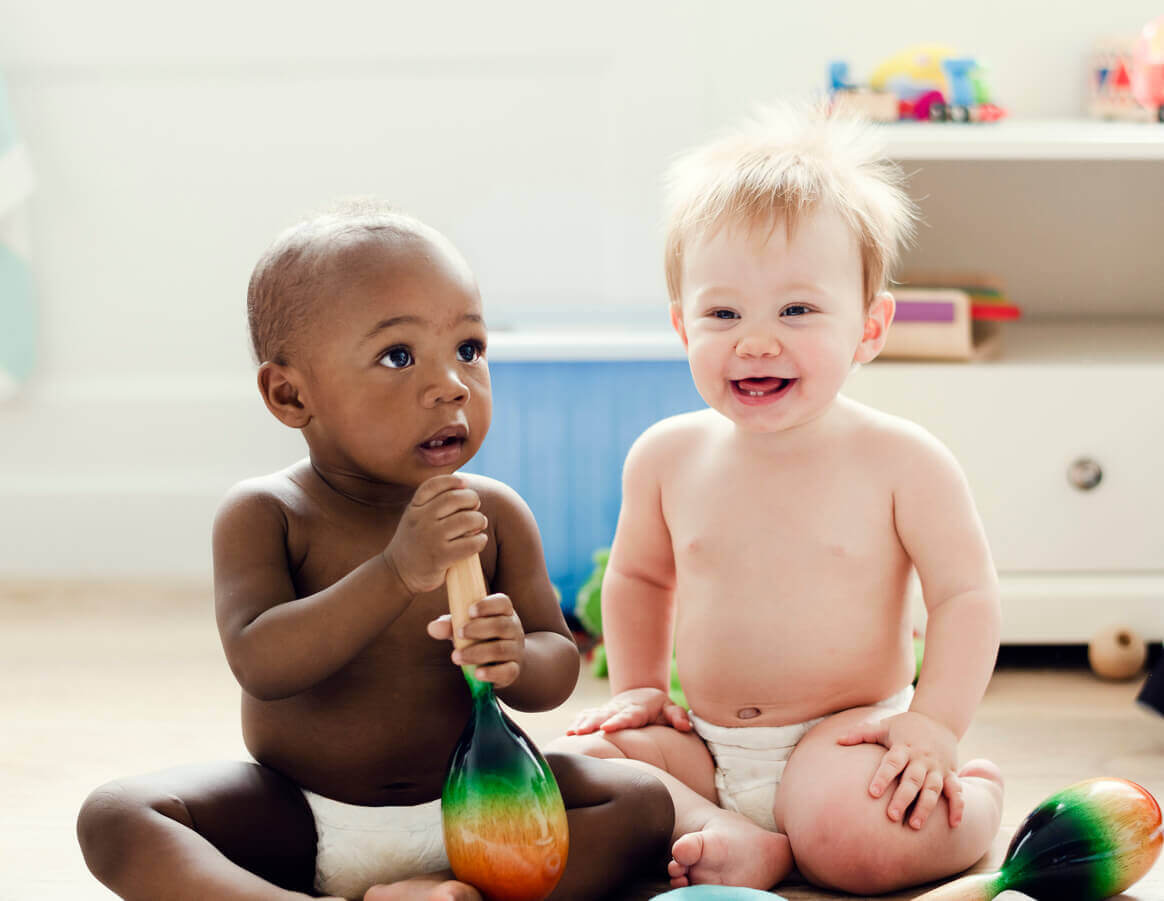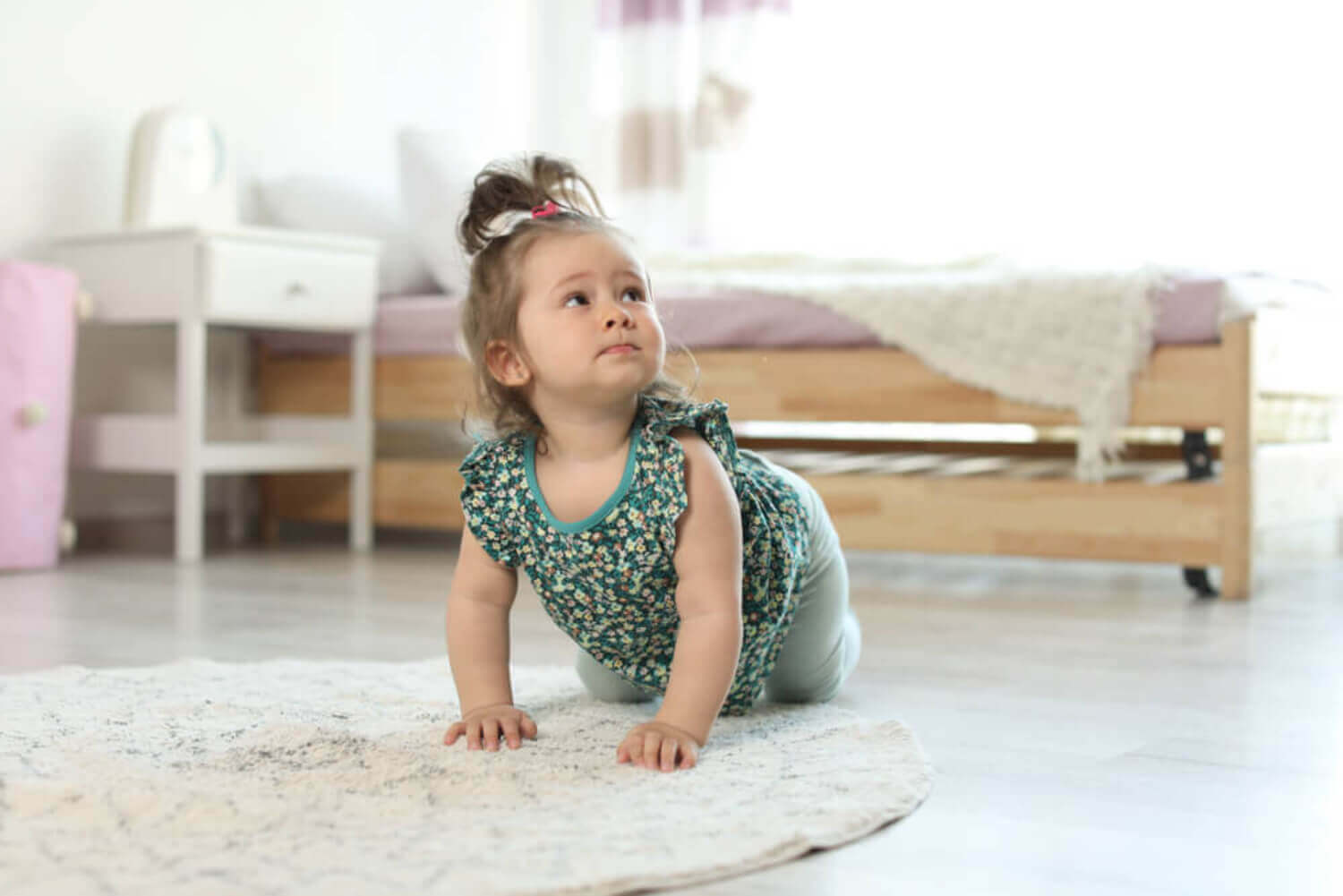Is it Bad if a Baby Doesn't Crawl?


Written and verified by degree in physical education and sports Andrés Felipe Cardona Lenis
If your baby doesn’t crawl, an unusual situation is likely to occur, but is it a bad thing?
In the personal experience of many families, crawling stands out as one of the most relevant stages in the psychomotor development of children. In fact, many people know that babies tend to scoot first, then crawl, and finally walk. But when a little one skips the intermediate stage, it can cause some concern in their caregivers.
For all of these reasons, today we invite you to know how important this milestone in motor development is and what its absence represents.
“My baby doesn’t crawl”
As a mother, it’s normal for you to be concerned if your baby doesn’t crawl. The first thing that comes to your mind is that something bad is happening with your child or that their psychomotor development process is delayed.
However, one of the main reasons why your little one isn’t yet crawling is because they’re not ready to do so. Remember that the learning process is different for everyone and that many factors come into play.
Pay attention to the following tips and implement as many as necessary.
Don’t compare their process to that of others

Relating with other parents is normal and serves to share experiences, advice, and recommendations. But this relationship also leads to constantly observing other people’s babies, both in their development and in their behavior. So, it’s likely that as time goes by, you begin to compare your child with those of others.
If you perceive that other children crawl without difficulty and that your little one still doesn’t, you’re likely to worry. However, the first thing you should do is avoid these types of comparisons and consult with your pediatrician regarding what to expect for that age. Likewise, you shouldn’t force your baby beyond their means just because others have already achieved that milestone.
Stimulate them, but don’t force them
As a mother, you can stimulate your baby in various aspects, especially to strengthen the different muscular and skeletal structures. However, the goal of stimulating them is focused on helping them achieve goals on their own. And for that, you must be patient and calm.
You can’t and shouldn’t try to force your baby to make a movement that they don’t want to do or aren’t ready to do. Rather, it’s best to motivate them to mobilize their arms, legs, and head to contribute to muscle strengthening and not to crawl faster. You can implement games or exercises with toys, which help encourage the child’s movement through space.
Remember to be patient and let them decide when to end the activity. Wait a while before the next exercise and if your child doesn’t show interest in continuing, postpone it until tomorrow.
Avoid overprotection
The importance of crawling for the physical and psychological development of the child is that this type of movement allows them to explore the environment on their own.
Babies are born with the need to interact with what surrounds them and to know how objects work. Therefore, being on the ground, they need to move to achieve their goal.
If you are a fearful or somewhat overprotective mother, you may limit your baby’s initiative to scoot or crawl. Therefore, it’s important that you reflect on your own attitudes regarding the care of your child before suspecting that they have a problem in their development.
Accept unusual crawling techniques as equivalent
There’s a chance that your baby will crawl in a less conventional way. You must understand that, although the crawling stage is within the sequence of motor milestones, the way to execute this movement isn’t predetermined.
Some babies crawl uniformly and others don’t, but the fundamental aspect is that they manage to move around the environment and have the possibility of exploring it freely.
What if your baby doesn’t crawl?
Although crawling is considered an important part of psychomotor development, many babies go directly from crawling to ambulation (walking on two feet). Even babies who skip the crawling stage without any other alteration in their development mature without negative psychological and motor consequences.
As mentioned above, the really important thing is that your baby manages some way to move on their own in order to interact with the environment when they want to.
However, according to a publication of the Acta de Investigación Psicológica, crawling can be closely related to the psychomotor development of the human being. This research offers a series of relevant data and results, which must be verified in depth through studies in various social settings.

If your baby doesn’t crawl, don’t worry
Psychomotor development is closely related to the child’s muscle movement, but not specifically to crawling. This isn’t to say that it’s not important, but that it’s not a fundamental maturational milestone.
Therefore, any child who’s constantly stimulated and can move autonomously will probably have adequate psychomotor development.
However, in case you have doubts on the subject, we recommend that you clarify them with your pediatrician.
If your baby doesn’t crawl, an unusual situation is likely to occur, but is it a bad thing?
In the personal experience of many families, crawling stands out as one of the most relevant stages in the psychomotor development of children. In fact, many people know that babies tend to scoot first, then crawl, and finally walk. But when a little one skips the intermediate stage, it can cause some concern in their caregivers.
For all of these reasons, today we invite you to know how important this milestone in motor development is and what its absence represents.
“My baby doesn’t crawl”
As a mother, it’s normal for you to be concerned if your baby doesn’t crawl. The first thing that comes to your mind is that something bad is happening with your child or that their psychomotor development process is delayed.
However, one of the main reasons why your little one isn’t yet crawling is because they’re not ready to do so. Remember that the learning process is different for everyone and that many factors come into play.
Pay attention to the following tips and implement as many as necessary.
Don’t compare their process to that of others

Relating with other parents is normal and serves to share experiences, advice, and recommendations. But this relationship also leads to constantly observing other people’s babies, both in their development and in their behavior. So, it’s likely that as time goes by, you begin to compare your child with those of others.
If you perceive that other children crawl without difficulty and that your little one still doesn’t, you’re likely to worry. However, the first thing you should do is avoid these types of comparisons and consult with your pediatrician regarding what to expect for that age. Likewise, you shouldn’t force your baby beyond their means just because others have already achieved that milestone.
Stimulate them, but don’t force them
As a mother, you can stimulate your baby in various aspects, especially to strengthen the different muscular and skeletal structures. However, the goal of stimulating them is focused on helping them achieve goals on their own. And for that, you must be patient and calm.
You can’t and shouldn’t try to force your baby to make a movement that they don’t want to do or aren’t ready to do. Rather, it’s best to motivate them to mobilize their arms, legs, and head to contribute to muscle strengthening and not to crawl faster. You can implement games or exercises with toys, which help encourage the child’s movement through space.
Remember to be patient and let them decide when to end the activity. Wait a while before the next exercise and if your child doesn’t show interest in continuing, postpone it until tomorrow.
Avoid overprotection
The importance of crawling for the physical and psychological development of the child is that this type of movement allows them to explore the environment on their own.
Babies are born with the need to interact with what surrounds them and to know how objects work. Therefore, being on the ground, they need to move to achieve their goal.
If you are a fearful or somewhat overprotective mother, you may limit your baby’s initiative to scoot or crawl. Therefore, it’s important that you reflect on your own attitudes regarding the care of your child before suspecting that they have a problem in their development.
Accept unusual crawling techniques as equivalent
There’s a chance that your baby will crawl in a less conventional way. You must understand that, although the crawling stage is within the sequence of motor milestones, the way to execute this movement isn’t predetermined.
Some babies crawl uniformly and others don’t, but the fundamental aspect is that they manage to move around the environment and have the possibility of exploring it freely.
What if your baby doesn’t crawl?
Although crawling is considered an important part of psychomotor development, many babies go directly from crawling to ambulation (walking on two feet). Even babies who skip the crawling stage without any other alteration in their development mature without negative psychological and motor consequences.
As mentioned above, the really important thing is that your baby manages some way to move on their own in order to interact with the environment when they want to.
However, according to a publication of the Acta de Investigación Psicológica, crawling can be closely related to the psychomotor development of the human being. This research offers a series of relevant data and results, which must be verified in depth through studies in various social settings.

If your baby doesn’t crawl, don’t worry
Psychomotor development is closely related to the child’s muscle movement, but not specifically to crawling. This isn’t to say that it’s not important, but that it’s not a fundamental maturational milestone.
Therefore, any child who’s constantly stimulated and can move autonomously will probably have adequate psychomotor development.
However, in case you have doubts on the subject, we recommend that you clarify them with your pediatrician.
All cited sources were thoroughly reviewed by our team to ensure their quality, reliability, currency, and validity. The bibliography of this article was considered reliable and of academic or scientific accuracy.
- Morales Suárez, A. y Rincón Lozada, F. (2016). Relación entre madurez neuropsicológica y presencia-ausencia de la conducta de gateo. Acta de investigación psicológica. Disponible en: http://www.scielo.org.mx/scielo.php?script=sci_arttext&pid=S2007-48322016000202450
- Oldak-Kovalsky, B. y Oldak-Skvirsky, D. (2015). Gateo. Revisión de la literatura médica. Revista Mexicana de Pediatría. Disponible en: https://www.medigraphic.com/pdfs/pediat/sp-2015/sp154f.pdf
This text is provided for informational purposes only and does not replace consultation with a professional. If in doubt, consult your specialist.








